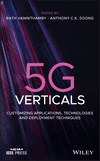The Requirements and Architectural Advances to Support URLLC Verticals
Summary
This chapter provides a self-contained overview of the vertical requirements as well as the technical and architectural concepts that is critical in delivering ultra-reliable and low-latency communications (URLLC) services. It presents a number of popular URLLC use cases. The chapter focuses on the new 5G network architecture and how it can be interfaced with URLLC applications. It explains the evolution of software defined networking and network function virtualization concepts, 5G core network and notions such as application specific slicing. A cloud-native architecture divides the tightly integrated and virtualized network functions-specific software stack into more scalable, reusable and efficiently deployable software components. The implications of cloud native network functions and architecture on provisioning URLLC services should be carefully considered. The 5G system service-based architecture and extensions for vertical and URLLC applications are under discussion in 3GPP standards.



